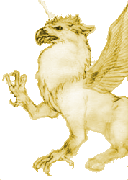
lionhawk, Torm's eagle
height; 4 feet at shoulder
length; 6 feet (excluding tail)
weight; males: 150 pounds
females: 140 pounds
Vicious in combat, griffons often using their talons to carry their prey to a great height and then drop them to their deaths. This is their favorite form of attack, but they can also use their powerful hind legs to rake an opponent. When protecting it's young however, they prefer to fight on the ground. Using their wings to beat at an opponents head, they then jump upon the victim's chest like a cat and use their teeth and talons, tearing and rending the flesh.
The gods use griffons to draw their chariots through the sky. They are also used to punish humans for their love of riches. When a man's love of money surpasses his love of his god, he can expect to find griffons sighted nearby.
This role was thrust upon the griffons when a large group of men invaded the dwarven mountains to steal the riches from within. The dwarves sought the aid of their god, Torm, to put an end to the menace. By then, the invaders had left the caverns and were heading across the plains back to their city. Torm called to the griffons and commanded them to tear the invaders apart. The griffons responded by doing just that. Torm was pleased by this and commanded the griffons to watch for those who would love riches more than any other, and destroy those they found. The griffons have obeyed this command ever since.
The dwarves rejoiced at these words and pay homage to the griffons for their aid every midsummer, and guard the nests of these creatures year round, though they never get too close. Even the dwarves, however, are not protected from the griffons should their love of money outweigh their love of all else.
For some unknown reason, griffons hate horses, and will attack any horse on sight. Often has a horse been seen splattered by the roadside, or a traveler found walking a great distance because his horse was carried off. It has never been explained why horses are so hated by these creatures. It is also rumored that if a young griffon is captured, it can be trained as a mount, but this rumor has never been confirmed.
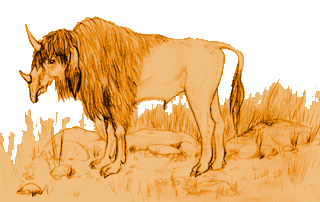
herbivore
weight; approximately 2000 pounds
gestation period; 14 moons
The soft undercoat makes a quality yarn or thread
The finest leathers come from naughahides
The naugha is a large herbivore with a thick wooly coat on the head and shoulders. The have a somewhat long, perhensile snout with which they efficiently crop even the shortest desert grasses. The humped back is said to store water, which enables them to go for long periods without drinking, as is sometimes necessary in the deserts. The males have two horns on thier foreheads. The females are hornless. They are quite capable of defending their young.
The Ogres keep large herds of these beasts and do not allow their export from Qabara.
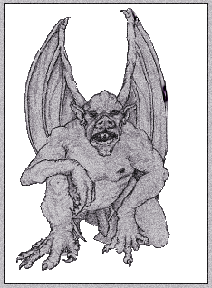
Gargoyles are often seen on roofs of tall buildings basking in the sun. It is difficult to realize that these stone statues are in all actuality living, breathing creatures.
Created from living rock by Torm as slaves to spy on his enemies, they have keen eyesight and great strength. Gorak took mercy on the creatures and freed them.
Gargoyles are a sign of luck and statues in their likeness are often carved and installed on the tops of walls of buildings. The gargoyles, flattered by this, often settle above a carving.
They have limited powers of speech, but are very wise.
The balatros, huge silver feathered birds, are used by the fates to send messages to the gods. They fly very high in the heavens and are often only discerned by the cloud trail they sometimes leave across the sky. Occasionally they can be seen flying at night, their red eyes glowing in the darkness and with the fierce light of the star torches clutched in their talons rivaling the constellations.
During times of trouble between the gods, many balatrosses can be seen in the skies. They are usually considered a bad omen.
Hoolie Hounds:
Hoolie hounds are large wolf-like creatures with rust-red to black coats, six toed feet, and glowing red eyes. They are exceedingly fast and agile and their hearing is exceptional. It's said that they can hear a man's heart at a hundred paces and that the sound drives them mad. They invariably attack this area first, and the still beating heart is the only thing they eat. The rest is left for the buzzards. Groups of corpses are often found in the wilderness with their hearts missing and hound tracks covering the area around them.
Legend tells us that Gorak, hating the unicorns, decided to hunt them. So it was that he sent his minions forth to find and kill as many as they could find. The minions were destroyed for it by Silvus Strongbow. Again Gorak sent forth minions, these more powerful than the last. Again they were destroyed.
Now incensed, Gorak turned himself into a fearsome beast. His eyes burned red with it's hate. He slaughtered whole herds of unicorns. Soon few were left. Men fought the beast, but always failed. Then the great warrior, Tristar, slew the beast with a magical sword.
Before his death, the beast mated with many hounds of Ereth. It's offspring live on in the form of hoolie hounds, with a hatred of man for killing their sire.
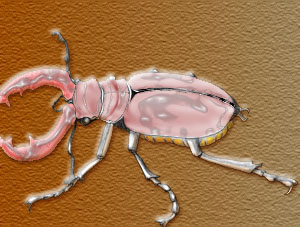
carrion eater
weight; approximately 95 pounds
length; 4 feet
egglayer
Source of corrosive acid
Cave beetles are cumbersome, slow moving, solitary creatures. They live in dank caverns, feeding on offal and carrion which they gather into huge piles in which they incubate their eggs. They are heavily armored with a hard exoskeleton. Their heavy mandibles inflict crushing damage on their victims. They are unintelligent and do not see or hear well, depending on their senses of taste and touch.
If attacked or disturbed they will bite. They can also emit a spray of acidic vapor from the rear end of their abdomen. This spray causes damage to exposed body parts.
The acid is created by the mixture of two substances produced by separate glands and combined in a third organ from which it is forcibly released. They can only produce it once every eight hours.
Glow Light Beetles:
These large beetles are three and a half feet long and weigh about 65 pounds. Found in deep caverns, they eat molds, slimes, and fungi. They often drag dead or decaying matter to their nest sites for the saprophytic plants to feed on.
They are generally considered non-aggressive. They have small mandibles but can still deliver a painful bite. Their main defense is a very tough horn, which can be up to 3 feet long.
Glow Light Beetles have glands above their eyes that produce a substance which creates a luminous glow. The beetles apparently use the secondary glowing "eyes" to frighten away predators. If the glands are removed while active, the glow persists for 6-12 hours. If they can be removed when not activated, they can be stored for an indefinite period of time and used as a light source by crushing them. They do not seem to produce heat.
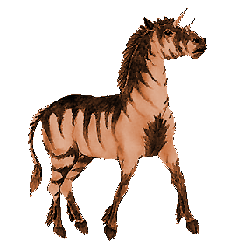
herbivore
height; 12 hands
weight; 900 pounds
gestation period; 11 months
Dumbass are herbivores, related to the unicorns. Their coloring varies with the seasons. They have dark brown, zebra like stripes with the background color changing from light brown to white during the winter months. They have hooves like unicorns but their manes and tails are shorter. They have two horns, one high on
They females and young live in family groups. They are very reclusive and territorial. They have one or two offspring a year. The females keep their young with them until sexual maturity at four years.
Male dumbasses are usually solitary creatures. They are combative if annoyed. During the mating season they are particularly testy. This is the only time the female dumbass tolerates the presence of the males. The males fight for dominance, the strongest mate, and then they resume their solitary existence.
Ink fish:
This is a large, many tentacled creature of the cold northern rivers with grayish black skin, large eyes, and a heavy frill at the base of the head.
It seems that these creatures have an internal ink sac that contains ink of a purple color that is prized by many of the barbarian tribes. It is indeed a unique color and has good staying power.
They are attracted to small, shiny objects and the Chendo tribe has found success in using bits of glass as bait.